2017/02/13: Driving, Driving, Driving...
Category: General
Posted by: The Agnew Family
It's been an uneventful, photo free day. That's a good thing when you're
trying to cover a lot of kilometers and I think we drove just under a
thousand kilometers. Oh, Ed just reminded me that it wasn't totally
uneventful --- the skies opened and rain poured down for about 10
minutes while he was driving, guess that's why I didn't notice.
We're spending the night just outside of Grove City, Pennsylvania and we're seeing a sight we haven't seen for awhile and aren't ready for. There's a few small piles of snow. We'll have to adjust in a hurry because I know there is snow on the ground at home.
We're only going as far as Burlington tomorrow, so it will be a much shorter day.
We're spending the night just outside of Grove City, Pennsylvania and we're seeing a sight we haven't seen for awhile and aren't ready for. There's a few small piles of snow. We'll have to adjust in a hurry because I know there is snow on the ground at home.
We're only going as far as Burlington tomorrow, so it will be a much shorter day.
2017/02/11: Long Beach Walk
Category: General
Posted by: The Agnew Family
It was a beautiful morning so we opted to spend the morning walking on
the St. Augustine beach. Ed and I both agreed that this beach is our
favourite beach in Florida.
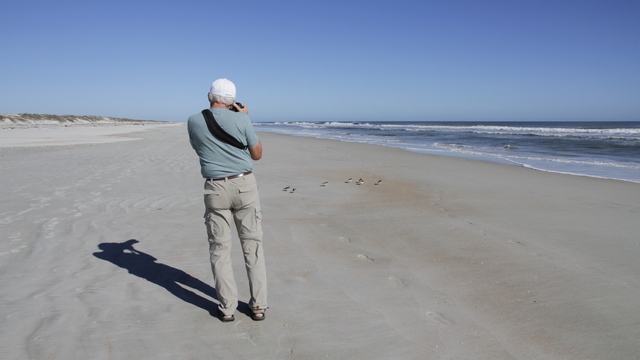
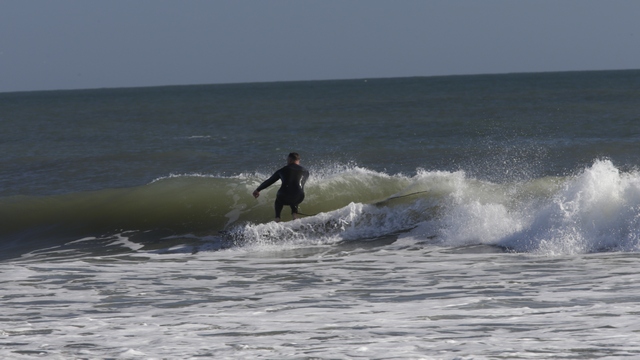
There were several surfers out enjoying the waves.
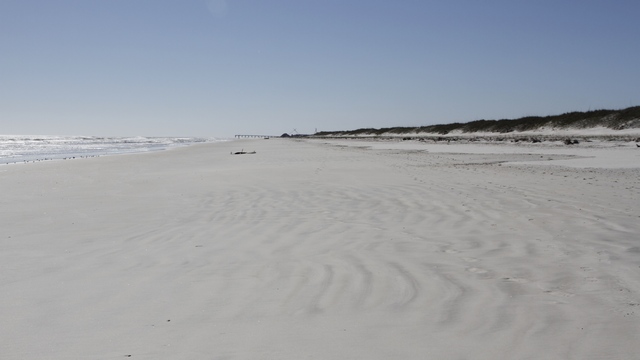
At times we had the beach to ourselves, other times we had to share the beach with these guys (actually a number of people were out enjoying the beach as well)
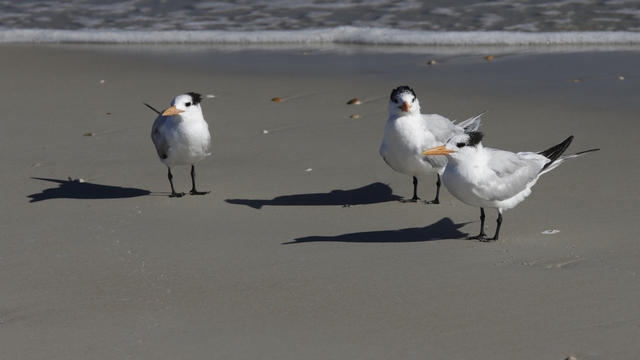
Royal Terns
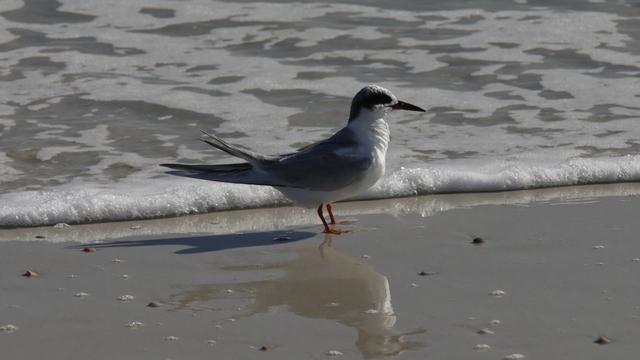
Foster's Tern


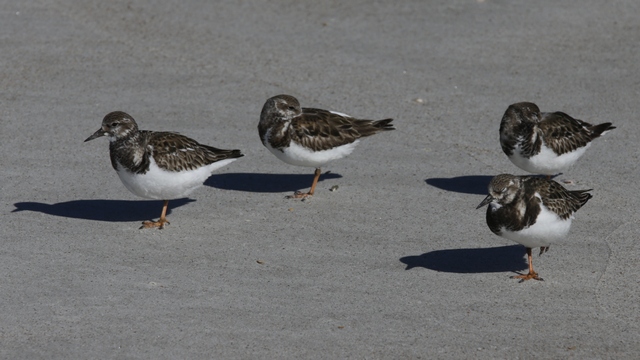
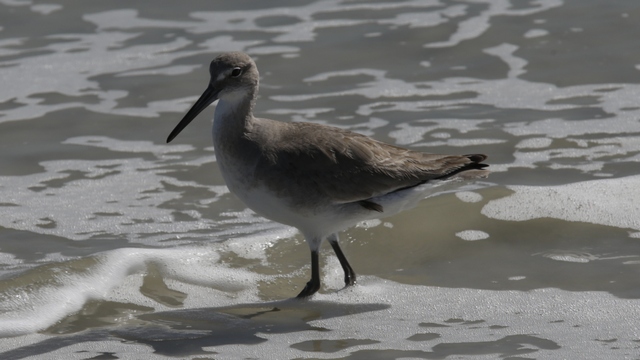
Finding a good motel/hotel room is a bit of a crap shoot in my opinion. So when we pulled into the hotel at 6pm and the parking lot was empty I really wondered what we would find. I was pleasantly surprised when we entered the room and it looked brand new --- fresh paint, new carpeting, new comforter. Ed was told that the motel's ownership changed two weeks ago. I guess the new owners are freshening the place up.
There were several surfers out enjoying the waves.
At times we had the beach to ourselves, other times we had to share the beach with these guys (actually a number of people were out enjoying the beach as well)
Royal Terns
Foster's Tern
Finding a good motel/hotel room is a bit of a crap shoot in my opinion. So when we pulled into the hotel at 6pm and the parking lot was empty I really wondered what we would find. I was pleasantly surprised when we entered the room and it looked brand new --- fresh paint, new carpeting, new comforter. Ed was told that the motel's ownership changed two weeks ago. I guess the new owners are freshening the place up.
2017/02/10: Birds, Kites and Lights
Category: General
Posted by: The Agnew Family
Ed has always wanted to photograph a Painted Bunting, so he was really
excited when he heard that they hung around the Merritt Island NWF
information center. Unfortunately, we didn't see one when we stopped at
the center two days ago. Deciding to give it one more chance before we
left the area we drove over to the information center and guess what we
saw.
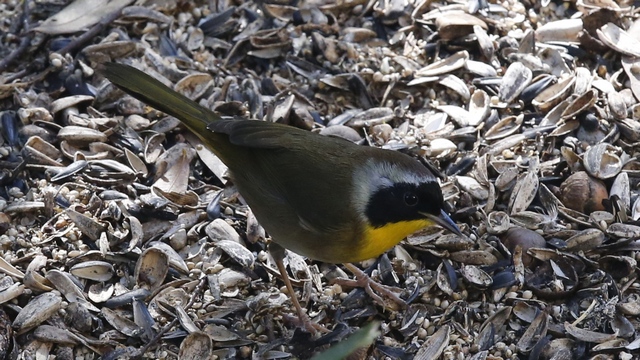
A Common Yellowthroat!!!!

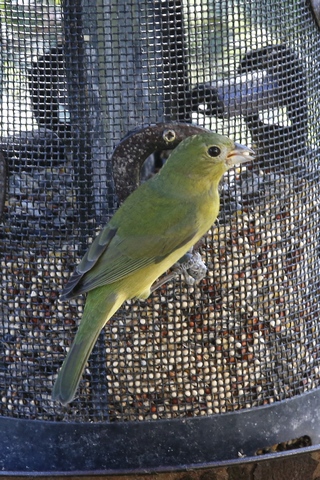
and Painted Buntings, a male, a female and a juvenile.
The bridge that links the two sides of the NWR together is out of commission as it is being repaired so we drove the long way around. Stopping at a Manatee viewing area we saw at least 6 manatee feeding.
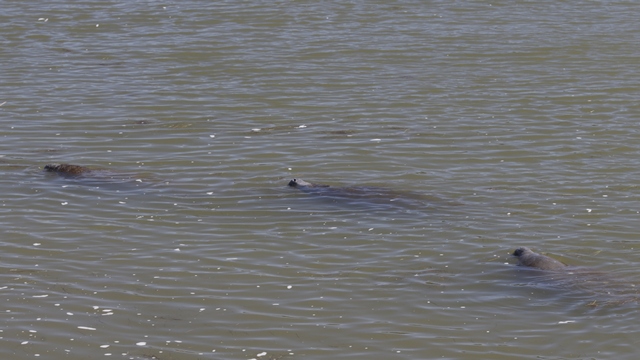
No stunning close ups but Ed did get 3 noses out of the water at the same time.
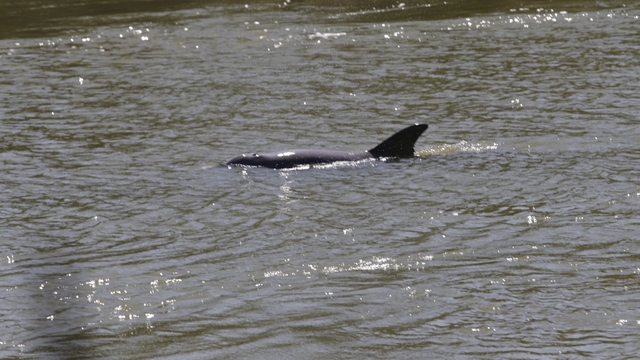
We also saw this dolphin feeding.
Next stop St. Augustine Beach.
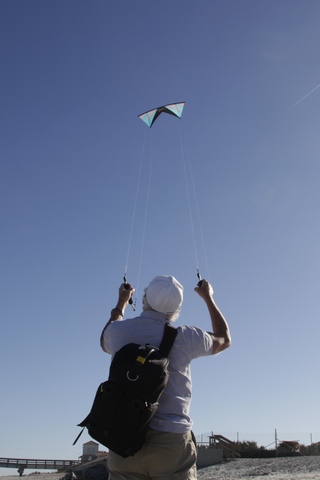
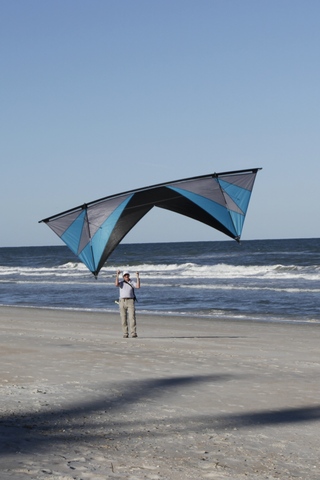
Ed finally got a chance to fly his kite. Unfortunately, the wind didn't co-operate so he only flew the kite for about 15 minutes. It has been a few years, so he was happy he remembered how to put the kite together and how to fly it. We need to find a big open deserted beach at home so we don't have to go south to fly the kite.
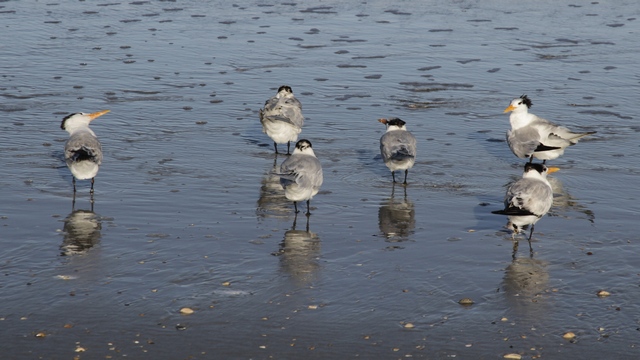
Walking along the beach we came across a flock of birds. If we got a little too close they walked a few steps away but didn't seem concerned we were there.
The main reason for stopping at St. Augustine Beach on the way home was to have dinner at Sunset Grill. When we spent a month in St. Augustine 3 years ago we ate at the grill several times and really enjoyed it. I'm happy to report that the food is still as good as it was 3 years ago. After dinner we drove to downtown St. Augustine, about a 10 minute drive.

The old city gates.
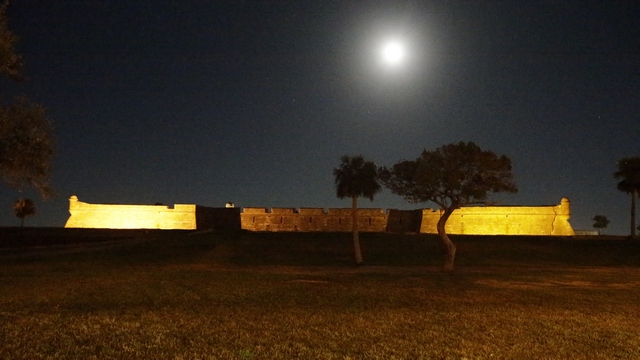
The moon over the fort.
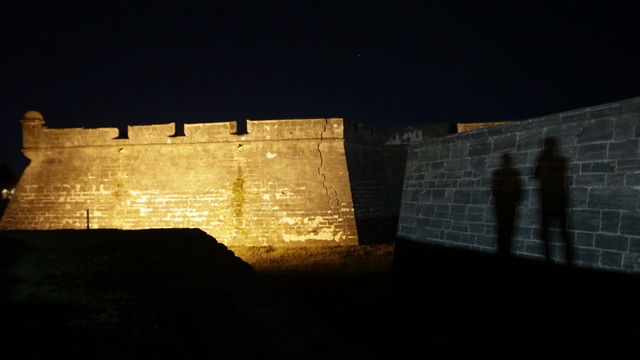
Didn't realize we were in front of a light till we saw the shadows.

A view of the bridge --- caught the light from the lighthouse.
A Common Yellowthroat!!!!
and Painted Buntings, a male, a female and a juvenile.
The bridge that links the two sides of the NWR together is out of commission as it is being repaired so we drove the long way around. Stopping at a Manatee viewing area we saw at least 6 manatee feeding.
No stunning close ups but Ed did get 3 noses out of the water at the same time.
We also saw this dolphin feeding.
Next stop St. Augustine Beach.
Ed finally got a chance to fly his kite. Unfortunately, the wind didn't co-operate so he only flew the kite for about 15 minutes. It has been a few years, so he was happy he remembered how to put the kite together and how to fly it. We need to find a big open deserted beach at home so we don't have to go south to fly the kite.
Walking along the beach we came across a flock of birds. If we got a little too close they walked a few steps away but didn't seem concerned we were there.
The main reason for stopping at St. Augustine Beach on the way home was to have dinner at Sunset Grill. When we spent a month in St. Augustine 3 years ago we ate at the grill several times and really enjoyed it. I'm happy to report that the food is still as good as it was 3 years ago. After dinner we drove to downtown St. Augustine, about a 10 minute drive.
The old city gates.
The moon over the fort.
Didn't realize we were in front of a light till we saw the shadows.
A view of the bridge --- caught the light from the lighthouse.
2017/02/09: Blast Off!!!
Category: General
Posted by: The Agnew Family
Over 30 years ago, Ed and I visited the Kennedy Space Center. Let me
tell you, it has changed a lot since then. Now I have to admit a lot has
happened in the space industry in those thirty years so that'll account
for a lot of the changes.
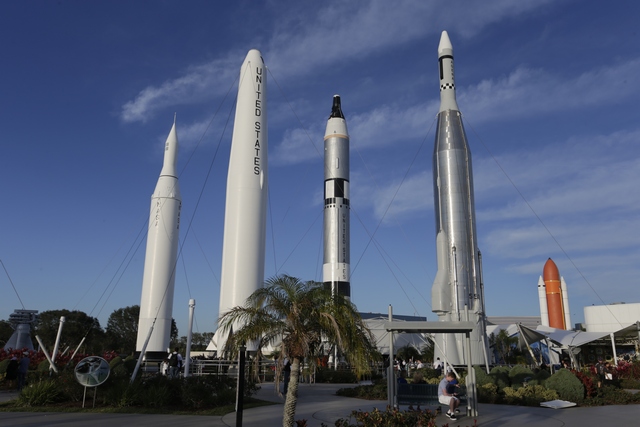
The Rocket Garden.
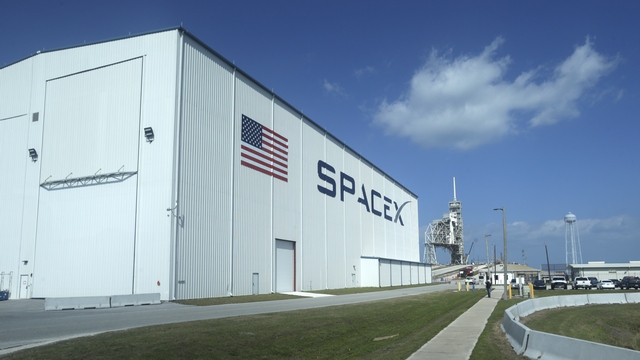
The name SPACEX did't mean anything to me, so I looked it up. "SpaceX designs, manufactures and launches advanced rockets and spacecraft. The company was founded in 2002 to revolutionize space technology, with the ultimate goal of enabling people to live on other planets." SpaceX is one of the companies that delivers supplies to the international space station.
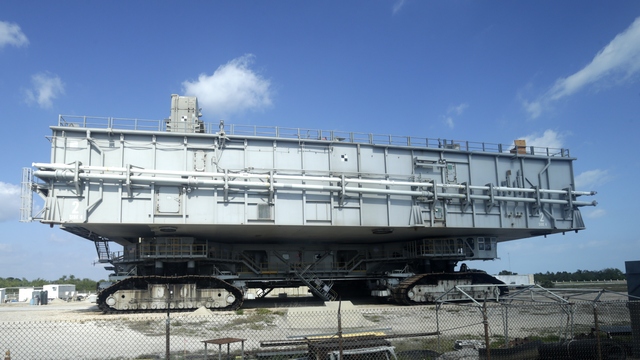
A "crawler" is used to move the rocket on a launch platform from the hanger to the launch area.
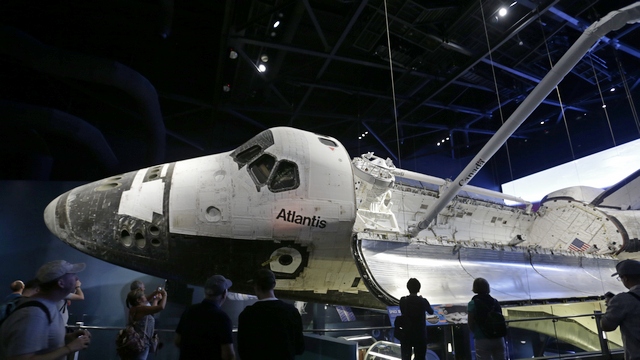
The space shuttle Atlantis is on display in the Atlantis exhibit. The CanadaArm is proudly displayed.
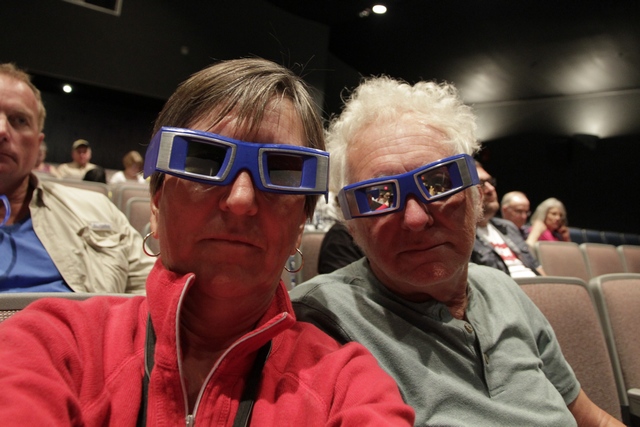
Ed and I ready to watch a 3D presentation.
The Rocket Garden.
The name SPACEX did't mean anything to me, so I looked it up. "SpaceX designs, manufactures and launches advanced rockets and spacecraft. The company was founded in 2002 to revolutionize space technology, with the ultimate goal of enabling people to live on other planets." SpaceX is one of the companies that delivers supplies to the international space station.
A "crawler" is used to move the rocket on a launch platform from the hanger to the launch area.
The space shuttle Atlantis is on display in the Atlantis exhibit. The CanadaArm is proudly displayed.
Ed and I ready to watch a 3D presentation.
2017/02/08: Back to the Birds
Category: General
Posted by: The Agnew Family
Borrowed from their website "Merritt Island National Wildlife Refuge
traces its beginnings to the development of the nationís Space Program.
In 1962, NASA acquired 140,000 acres of land, water, and marshes
adjacent to Cape Canaveral to establish the John F. Kennedy Space
Center. NASA built a launch complex and other space-related facilities,
but development of most of the area was not necessary. In 1963 the U.S.
Fish and Wildlife Service signed an agreement to establish the refuge
and in 1975 a second agreement established Canaveral National Seashore.
Today, the Department of Interior manages most of the unused portions of
the Kennedy Space Center as a National Wildlife Refuge and National
Seashore."
All I can say is Thank you NASA for buying this land and sharing it with the public.
The National Wildlife Refuge Black Point Wildlife Drive is a 7 mile auto tour offering the best chance to see wildlife. Generally, the best time to see wildlife is early in the morning and late in the afternoon. Knowing this Ed and I decided we would do the drive twice, first thing in the morning (I actually had Ed in the car at 7:15 am) and again around 4pm.
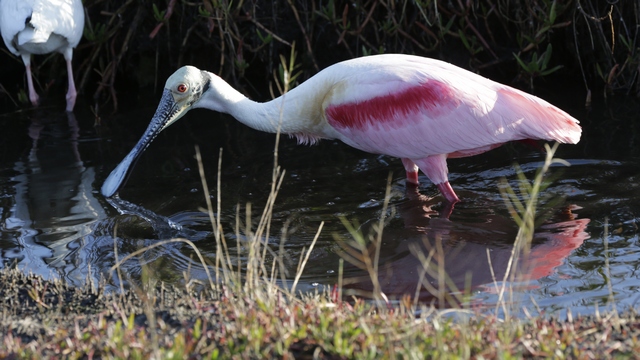
Roseate Spoonbill is always a favourite with birders.

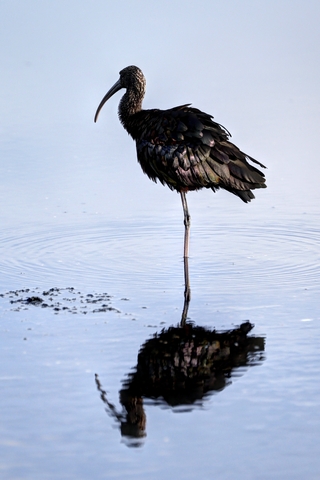
A Snowy Egret in breeding plumage and a Glossy Ibis.
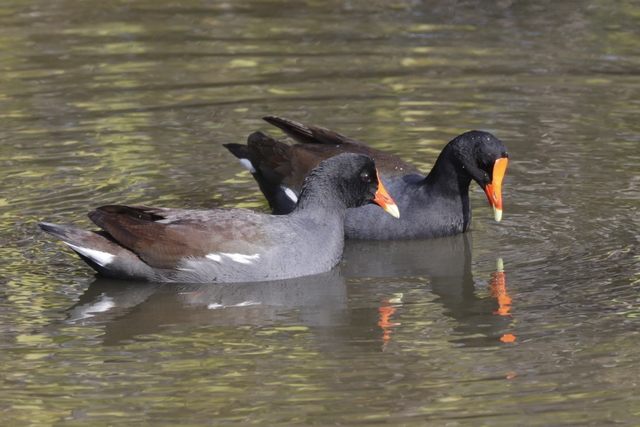
A couple of Moorhens.
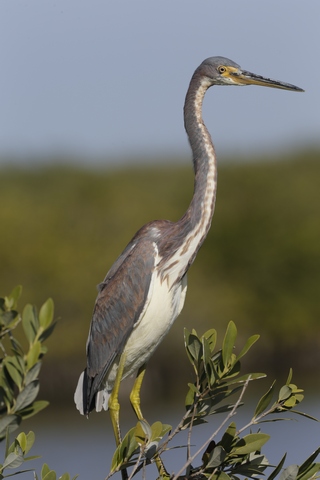
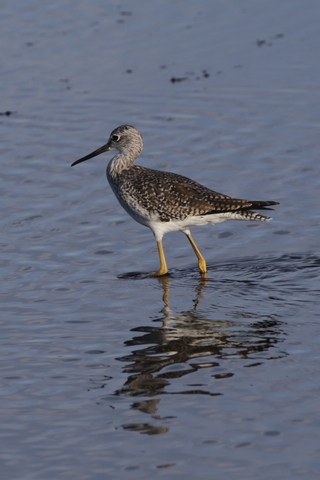
A Tricolored Heron and a Yellowlegs.
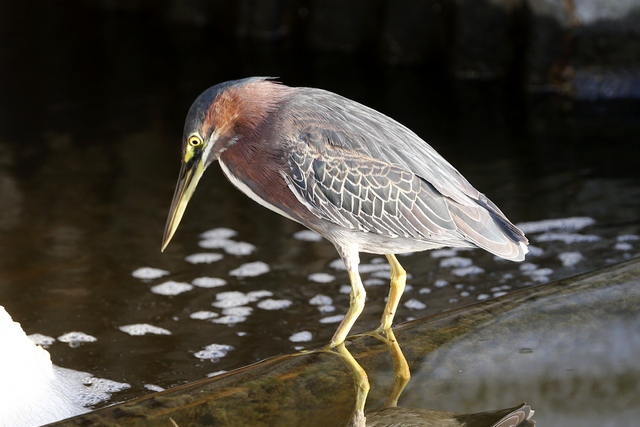
A Green Heron fishing in a drain pipe.
At one stop along the drive we saw a number of Coots. We also saw two small alligators. After a few minutes we noticed the alligators had disappeared. A few minutes later the coots started acting funny.
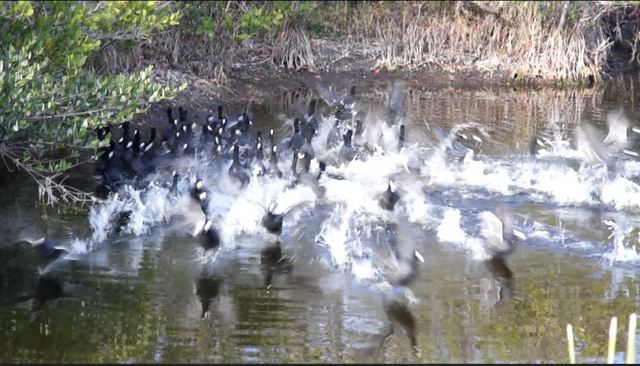
All of a sudden the Coots took off ---- they didn't fly but ran on the water. Something was scaring them.
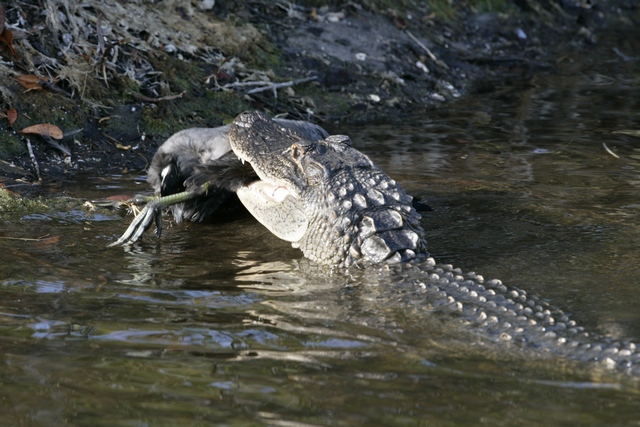
A little further up the waterway a fellow watched as an alligator caught himself a bird. We arrived a couple of minutes later. The bird was a little big for the gator but he was determined he was going to eat it.

The Coots were pretty nervous. They stayed in a tight group and got out of the water. Surprisingly, they actually stayed near the alligator who was munching on their buddy.
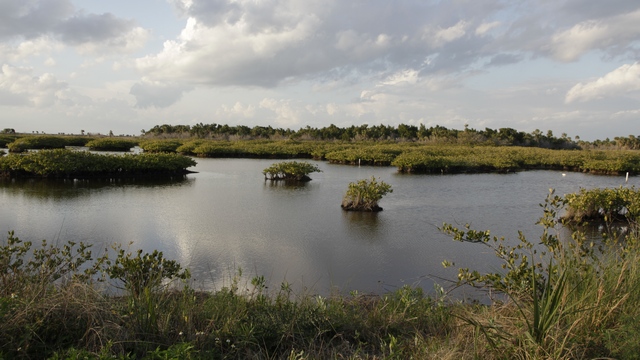
The afternoon light gave the refuge a beautiful glow.
During the middle of the day we drove around the rest of the reserve and onto the Canaveral National Seashore.
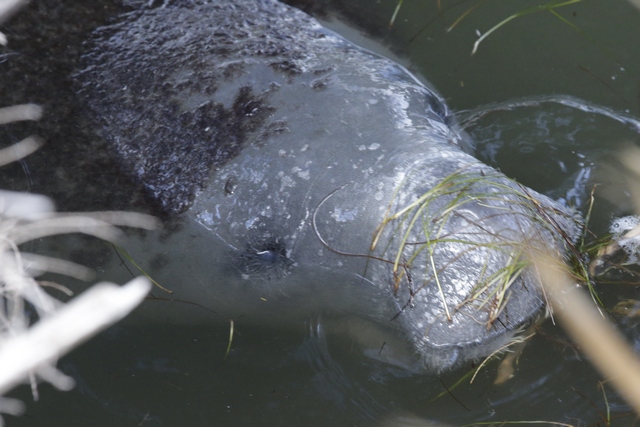
In one area we saw lots and lots of Manatee. At one spot we saw three Manatee eating together. Several of the Manatee had barnacles on their backs.


On this trip we've seen a lot of Vultures and only a few hawks, so it was nice to see this Red-shouldered Hawk (we think) on a telephone pole. A bunch of sandpiper class birds were hanging out on the beach.

The beach at Cape Canaveral.
All I can say is Thank you NASA for buying this land and sharing it with the public.
The National Wildlife Refuge Black Point Wildlife Drive is a 7 mile auto tour offering the best chance to see wildlife. Generally, the best time to see wildlife is early in the morning and late in the afternoon. Knowing this Ed and I decided we would do the drive twice, first thing in the morning (I actually had Ed in the car at 7:15 am) and again around 4pm.
Roseate Spoonbill is always a favourite with birders.

A Snowy Egret in breeding plumage and a Glossy Ibis.
A couple of Moorhens.
A Tricolored Heron and a Yellowlegs.
A Green Heron fishing in a drain pipe.
At one stop along the drive we saw a number of Coots. We also saw two small alligators. After a few minutes we noticed the alligators had disappeared. A few minutes later the coots started acting funny.
All of a sudden the Coots took off ---- they didn't fly but ran on the water. Something was scaring them.
A little further up the waterway a fellow watched as an alligator caught himself a bird. We arrived a couple of minutes later. The bird was a little big for the gator but he was determined he was going to eat it.
The Coots were pretty nervous. They stayed in a tight group and got out of the water. Surprisingly, they actually stayed near the alligator who was munching on their buddy.
The afternoon light gave the refuge a beautiful glow.
During the middle of the day we drove around the rest of the reserve and onto the Canaveral National Seashore.
In one area we saw lots and lots of Manatee. At one spot we saw three Manatee eating together. Several of the Manatee had barnacles on their backs.
On this trip we've seen a lot of Vultures and only a few hawks, so it was nice to see this Red-shouldered Hawk (we think) on a telephone pole. A bunch of sandpiper class birds were hanging out on the beach.
The beach at Cape Canaveral.
Category: General
Posted by: The Agnew Family
My Florida Guide Book listed a museum with Japanese Art in Delray. We
planned on visiting the museum this morning but that changed when we
found out that the large exhibit hall was closed as a new show was being
installed.
Time for plan B. Take the slow drive up A1A instead of highway 95 to our destination Titusville. This worked up to a point. A1A was beyond slow as well as boring ---- a few glimpses of the ocean between hedges and trees. And then there was the rain. The skies opened, the rain came down and the roads flooded. Luckily it didn't rain for long so the flooding also didn't last long.
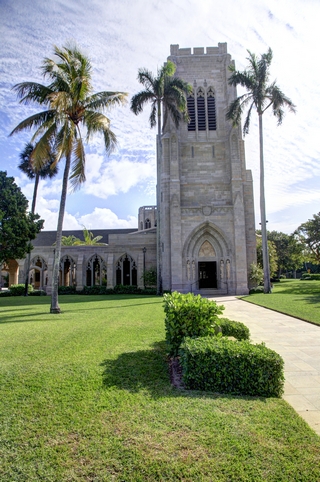
A beautiful church.
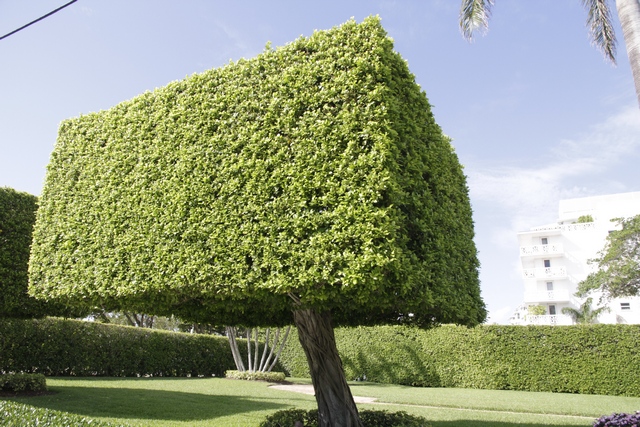
A square tree. The Palm Beach area loves shaping trees and hedges.

We stopped and checked out one of the beaches along A1A.
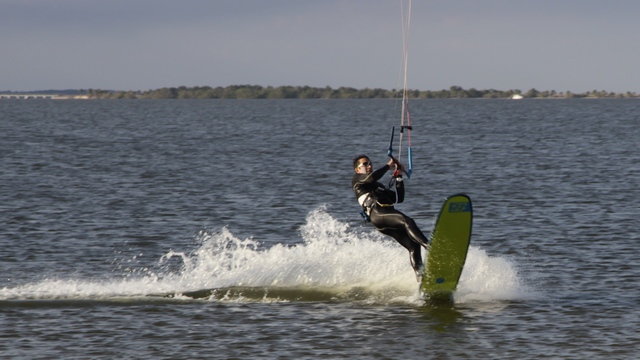
This kite surfer was enjoying the sun that came out after the rain.
Time for plan B. Take the slow drive up A1A instead of highway 95 to our destination Titusville. This worked up to a point. A1A was beyond slow as well as boring ---- a few glimpses of the ocean between hedges and trees. And then there was the rain. The skies opened, the rain came down and the roads flooded. Luckily it didn't rain for long so the flooding also didn't last long.

A beautiful church.
A square tree. The Palm Beach area loves shaping trees and hedges.
We stopped and checked out one of the beaches along A1A.
This kite surfer was enjoying the sun that came out after the rain.
2017/02/06: Lake Worth
Category: General
Posted by: The Agnew Family
Ed and I left Miami today, driving north to Lake Worth. Ed found an amazing little motel.
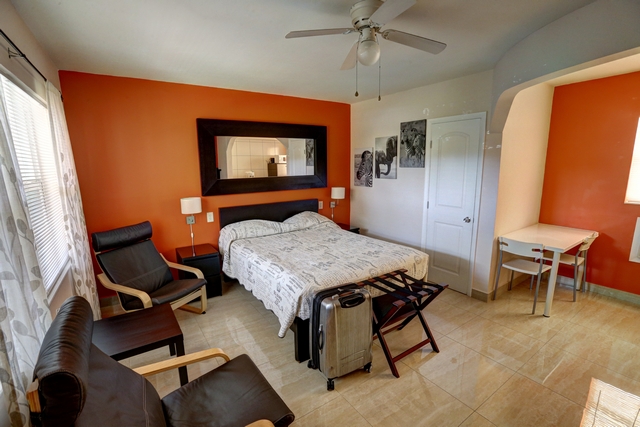
My first impression was that I was in an Ikea model room. It is beautiful and clean.
We wandered around Lake Worth and found these guys.

Ibis all in a row.
Lake Worth Beach is found on the strip of land on the far side of Lake Worth Lagoon.
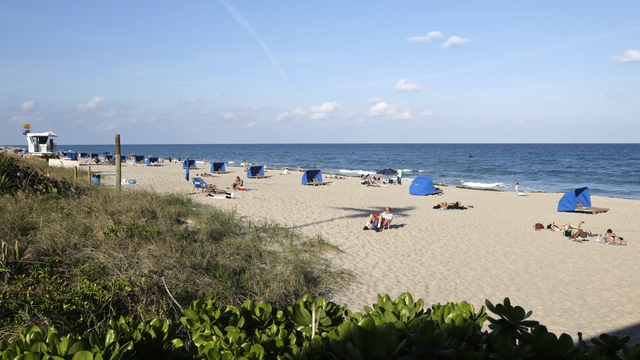
The Lake Worth Beach is describe as the best beach between Fort Lauderdale and Daytona.

Like most beaches, this one has a fishing pier.
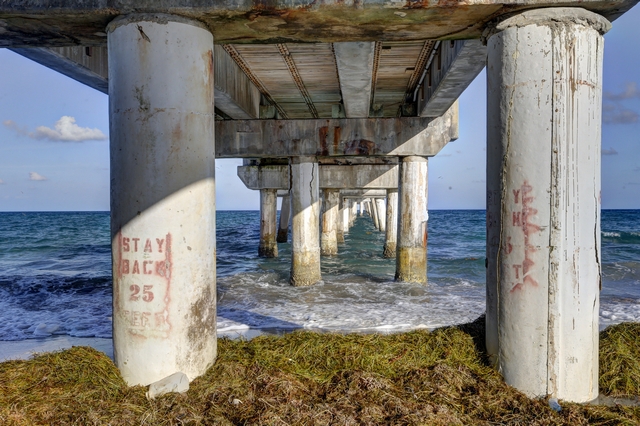
Art shot.
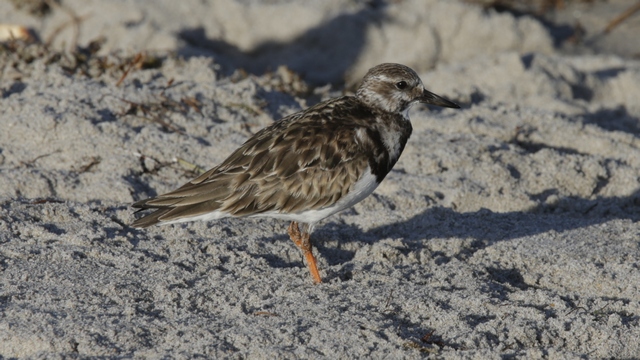
These birds were enjoying the grasses on the beach that had been pushed in by the tide.
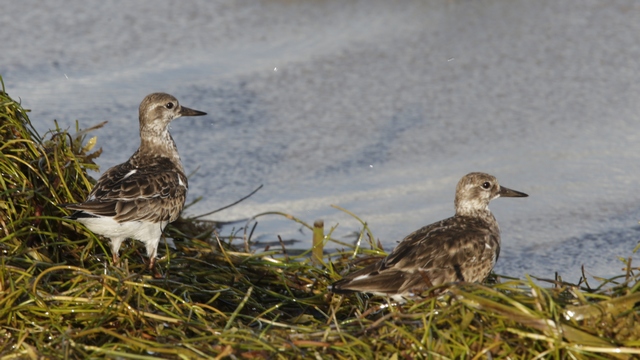

My first impression was that I was in an Ikea model room. It is beautiful and clean.
We wandered around Lake Worth and found these guys.
Ibis all in a row.
Lake Worth Beach is found on the strip of land on the far side of Lake Worth Lagoon.
The Lake Worth Beach is describe as the best beach between Fort Lauderdale and Daytona.

Like most beaches, this one has a fishing pier.

Art shot.
These birds were enjoying the grasses on the beach that had been pushed in by the tide.
2017/02/05: Flager Museum
Category: General
Posted by: The Agnew Family
Henry Flagler was a founding partner in Standard Oil along with John D.
Rockefeller and Samuel Andrews. In his fifties, Flagler's interests
turned to the development of Florida. By 1912, Flagler's Florida East
Coast Railway, and the luxury hotels he built along the way, linked the
entire east coast of Florida from Jacksonville to Key West.
In 1902, Flagler built Whitehall. With more than 75 rooms, Whitehall was a winter retreat and wedding present for his wife, Mary Lily Kenan Flagler.
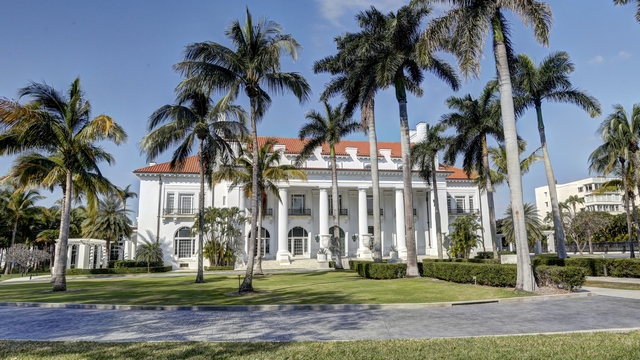
The outside of Whitehall.
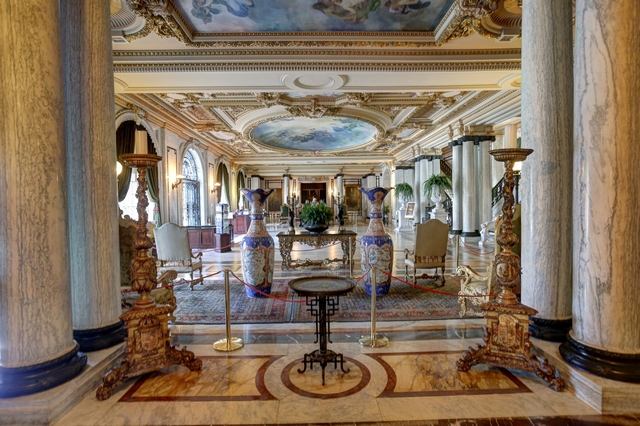
The Grand Hall seen from the Drawing Room.
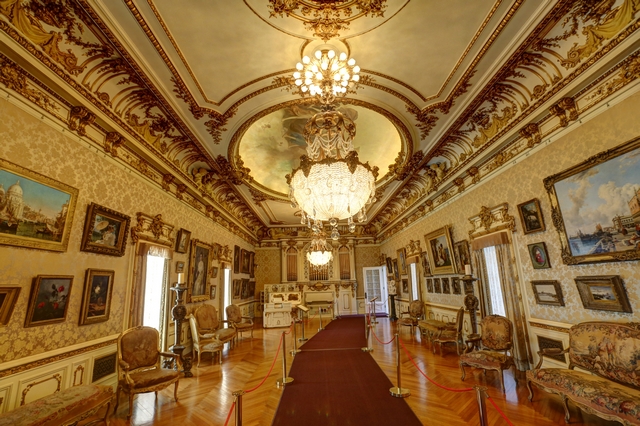
The Music Room. At the end of the music room is a 1,249 pipe JH &CS; Odell Co. organ.

Every room has a unique ceiling, crown molding and door molding. The library had cherubs in the crown molding.
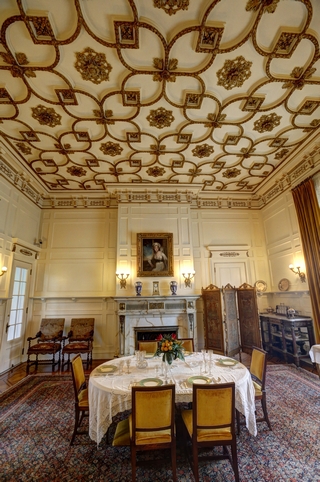

The breakfast room was beside the much more formal dinning room.

My favorite room in the house was the drawing room which was the room Mrs. Flager used to entertain visiting women.
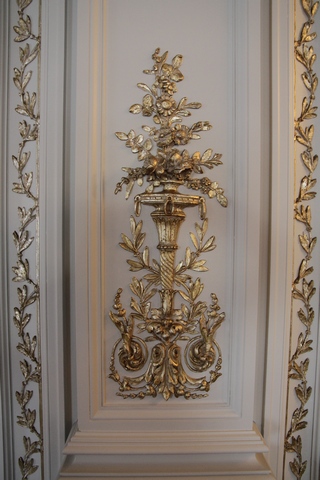
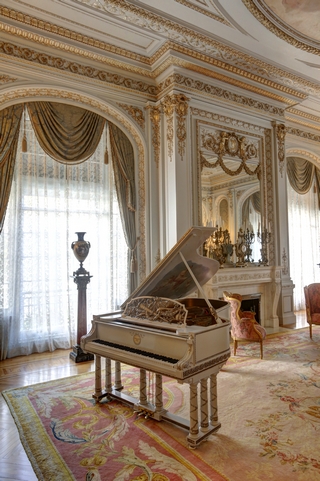
Aluminum leaf highlights the plaster ornaments in the Drawing Room. When the house was built the process of extracting aluminum economically had not yet been perfected and as a result was more expensive and precious than gold. The piano was specially built for this room.
The second floor of Whitehall was designed as private living space for the Flaglers, their guests, and domestic staff. In addition to the Master Suite, there were originally fourteen guest chambers, thirteen servant's rooms, seventeen bathrooms, and Mrs. Flagers' sitting room.
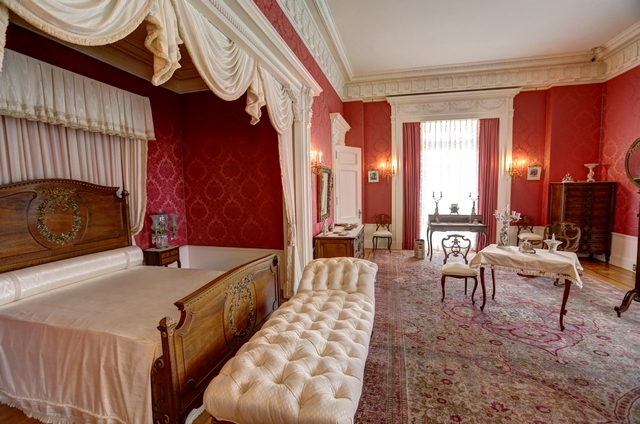
This is the "Red Room". Each guest bedroom was done in a different colour or style.
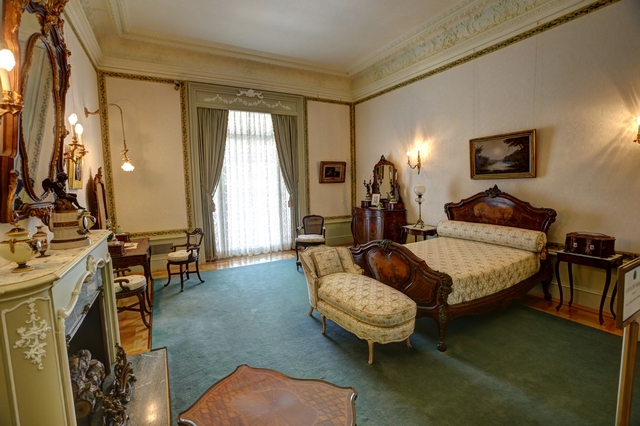
Ed and I chose this bedroom as I one we would like to stay in.
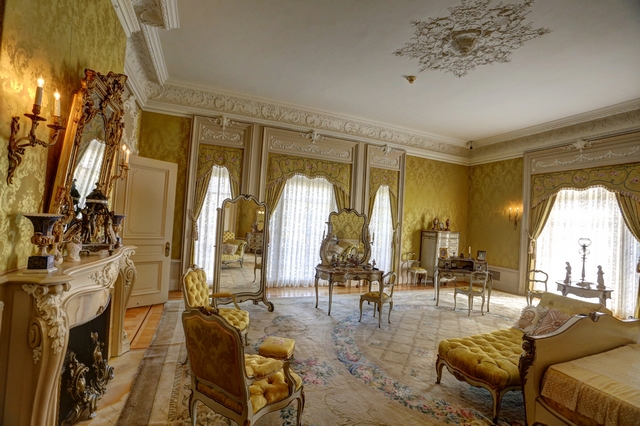
The Flager's suite was opulent. It had a huge bathroom and dressing room. The bathroom even had a telephone in it.
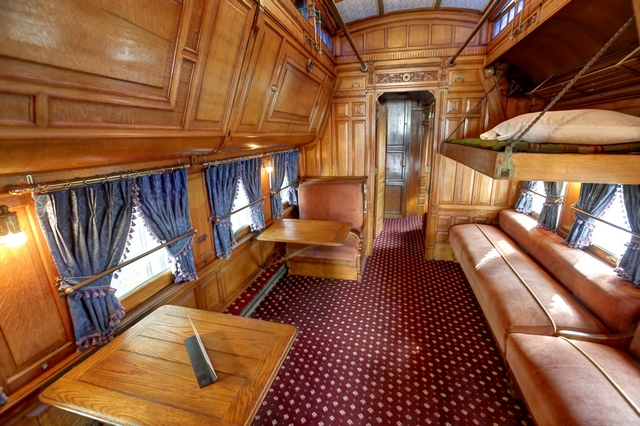
Mr. Flagler also had a personal train car. The train car is in a specially designed building to protect it from the elements.
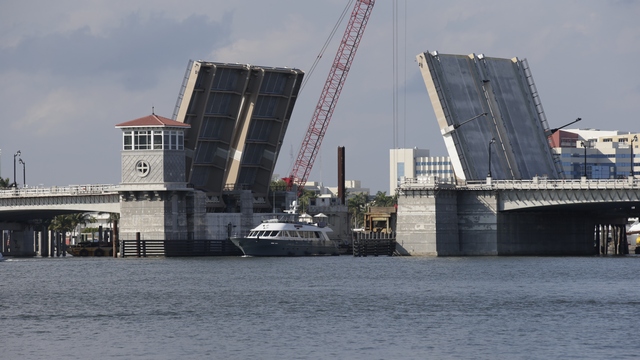
Whitehall backs onto the inland waterway. Two draw bridges can be seen from the yard. We watched this one raise to let a ship through.
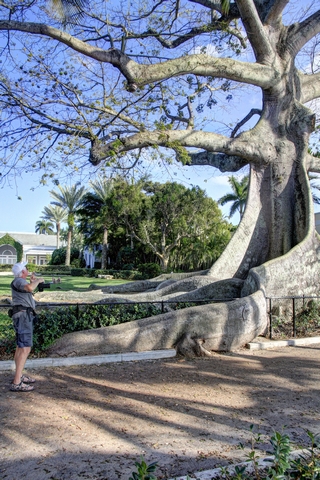

This Kapok tree is in the backyard of the Royal Poinciana Chapel. This chapel was built on land donated by Flagler.
Palm Beach is definitely the home of the rich. The homes were incredible, those you could peak at through or around the hedges. Even the seashore had hedges blocking the views (this may also help block water during a storm). One street was lined with trees and filled with expensive stores.

We finally managed to find a public beach.
In 1902, Flagler built Whitehall. With more than 75 rooms, Whitehall was a winter retreat and wedding present for his wife, Mary Lily Kenan Flagler.

The outside of Whitehall.

The Grand Hall seen from the Drawing Room.

The Music Room. At the end of the music room is a 1,249 pipe JH &CS; Odell Co. organ.
Every room has a unique ceiling, crown molding and door molding. The library had cherubs in the crown molding.


The breakfast room was beside the much more formal dinning room.

My favorite room in the house was the drawing room which was the room Mrs. Flager used to entertain visiting women.

Aluminum leaf highlights the plaster ornaments in the Drawing Room. When the house was built the process of extracting aluminum economically had not yet been perfected and as a result was more expensive and precious than gold. The piano was specially built for this room.
The second floor of Whitehall was designed as private living space for the Flaglers, their guests, and domestic staff. In addition to the Master Suite, there were originally fourteen guest chambers, thirteen servant's rooms, seventeen bathrooms, and Mrs. Flagers' sitting room.

This is the "Red Room". Each guest bedroom was done in a different colour or style.

Ed and I chose this bedroom as I one we would like to stay in.

The Flager's suite was opulent. It had a huge bathroom and dressing room. The bathroom even had a telephone in it.

Mr. Flagler also had a personal train car. The train car is in a specially designed building to protect it from the elements.
Whitehall backs onto the inland waterway. Two draw bridges can be seen from the yard. We watched this one raise to let a ship through.


This Kapok tree is in the backyard of the Royal Poinciana Chapel. This chapel was built on land donated by Flagler.
Palm Beach is definitely the home of the rich. The homes were incredible, those you could peak at through or around the hedges. Even the seashore had hedges blocking the views (this may also help block water during a storm). One street was lined with trees and filled with expensive stores.
We finally managed to find a public beach.
2017/02/04: South East End of the Everglades
Category: General
Posted by: The Agnew Family
Today has been a really long day. Ed and I hit the road about 7:30am and
arrived home at 9:10pm. The everglades were wonderful and we saw almost
everything we were hoping to see. That means there are lots of photos
for Ed to look at and "process". It also means I won't get to choose my
photos for the blog till tomorrow. Unfortunately for the blog and
fortunately for us, we have plans that will put us on the road by 9am so
it maybe evening before I work on today's blog again.
We pulled into the parking lot at the Royal Palm area in the Everglades and noticed tarps covering vehicles and black vultures sitting on the cars. Ed grabbed a tarp and bungee cords from a bin by the washrooms and covered our car in the same fashion we saw other cars covered.
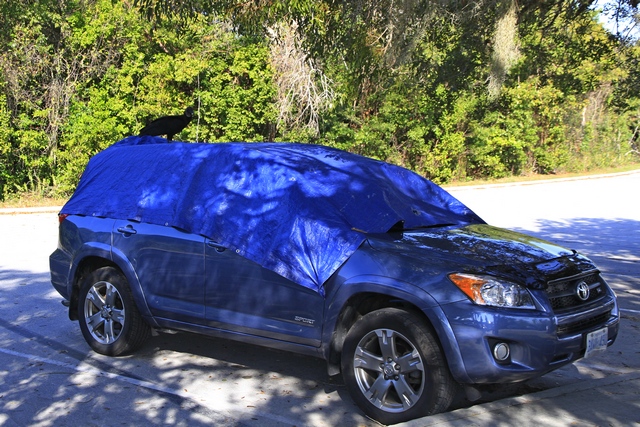
We had barely walked away from our car when a vulture landed on the roof.
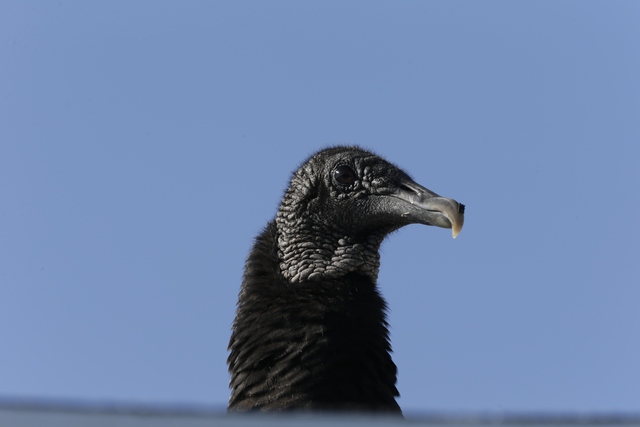
While the number of people visitors were low, the vultures hung around.
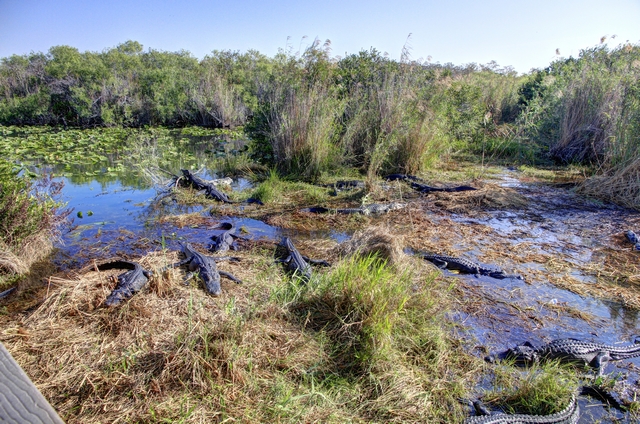
It was a little over whelming when you walked to the end of a look out and saw this. I think there are at least 12 full or part alligators in this photo.

I think this one is looking for trouble.
A park ranger told us where he has seen Purple Gallinules. Ed was really happy when he found not one, not two but three Purple Gallinules walking on the lily pads.
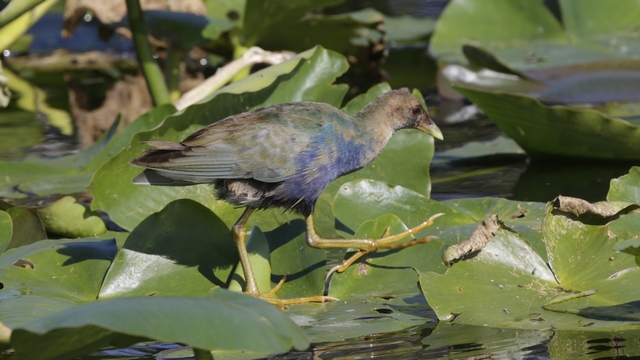
This is an immature Purple Gallinule. One distinctive feature are the very large feet.

This is an adult Purple Gallinule.
The trail we walked to see the alligators and purple gallinule was called the Anhinga Trail and yes there were lots of Anhingas on the trail.
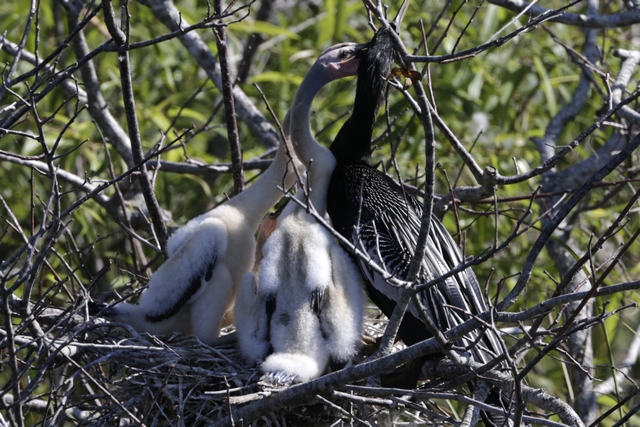
In fact we saw a number of baby anhingas. They are cute fuzzy little and not so little birds.

Leaving Royal Palm we drove further south into the Everglades. We had a good laugh when we saw this sign.
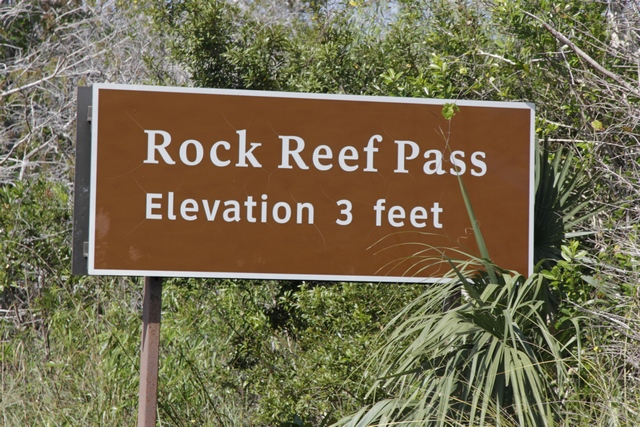
If you've ever driven through the mountains you will have seen many signs similar to this.
I'm still having trouble wrapping my head around "the everglades" being a "sea of grass". I guess I've watched too many TV shows with air boats zipping through the glades.
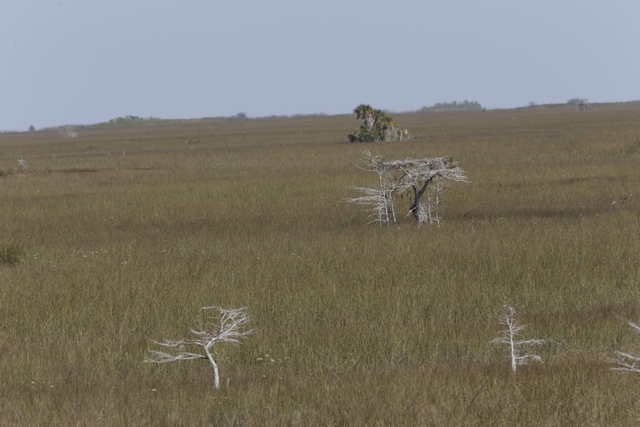
In some areas of the everglades Cypress trees grow. Yes, Cypress trees like water.

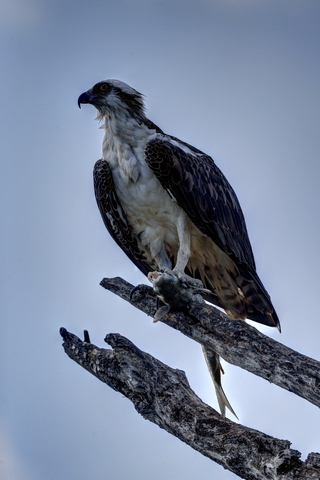
We don't normally take photos of crows but this one was playing peek-a-boo with Ed. I think he wanted Ed's sandwich. That's our car the crow is sitting on. The Osprey didn't need any of Ed's lunch he caught him self a good size fish.
At the southern end of the Everglades is Flamingo. The rangers tell us that this is the only place in the world where Crocodiles and Alligators co-exist. Apparently the everglades is the only place that provides conditions suitable to both Crocodiles and Alligators.

A big old crocodile.
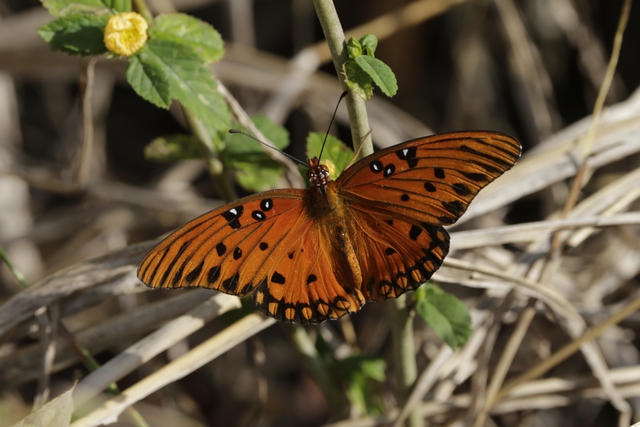
We also saw lots of different butterflies. Finally one stayed still long enough for a photo.
As evening started to fall the birds started returning to the ponds where they roost.
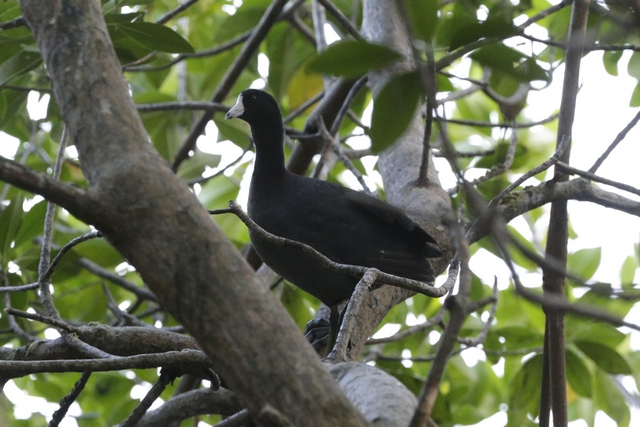
This Coot's already staked out his spot in a mangrove bush.
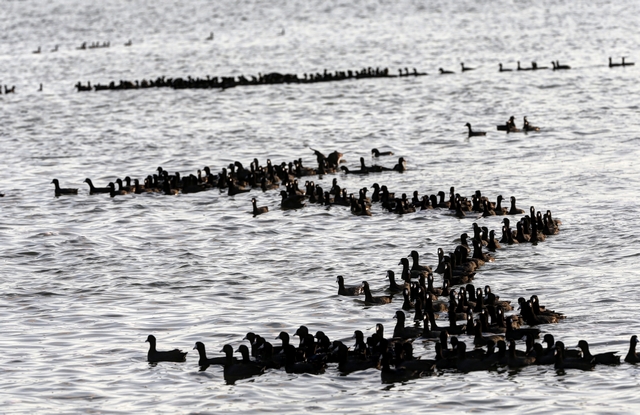
The pond was full of groups of Coots. This was a very noisy spot as the Coots organized themselves for the night.
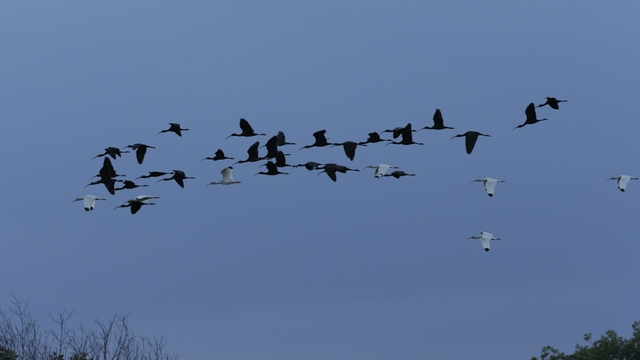
At another pond, Ibis were flying in.
We pulled into the parking lot at the Royal Palm area in the Everglades and noticed tarps covering vehicles and black vultures sitting on the cars. Ed grabbed a tarp and bungee cords from a bin by the washrooms and covered our car in the same fashion we saw other cars covered.
We had barely walked away from our car when a vulture landed on the roof.
While the number of people visitors were low, the vultures hung around.

It was a little over whelming when you walked to the end of a look out and saw this. I think there are at least 12 full or part alligators in this photo.

I think this one is looking for trouble.
A park ranger told us where he has seen Purple Gallinules. Ed was really happy when he found not one, not two but three Purple Gallinules walking on the lily pads.
This is an immature Purple Gallinule. One distinctive feature are the very large feet.

This is an adult Purple Gallinule.
The trail we walked to see the alligators and purple gallinule was called the Anhinga Trail and yes there were lots of Anhingas on the trail.
In fact we saw a number of baby anhingas. They are cute fuzzy little and not so little birds.

Leaving Royal Palm we drove further south into the Everglades. We had a good laugh when we saw this sign.
If you've ever driven through the mountains you will have seen many signs similar to this.
I'm still having trouble wrapping my head around "the everglades" being a "sea of grass". I guess I've watched too many TV shows with air boats zipping through the glades.
In some areas of the everglades Cypress trees grow. Yes, Cypress trees like water.

We don't normally take photos of crows but this one was playing peek-a-boo with Ed. I think he wanted Ed's sandwich. That's our car the crow is sitting on. The Osprey didn't need any of Ed's lunch he caught him self a good size fish.
At the southern end of the Everglades is Flamingo. The rangers tell us that this is the only place in the world where Crocodiles and Alligators co-exist. Apparently the everglades is the only place that provides conditions suitable to both Crocodiles and Alligators.

A big old crocodile.
We also saw lots of different butterflies. Finally one stayed still long enough for a photo.
As evening started to fall the birds started returning to the ponds where they roost.
This Coot's already staked out his spot in a mangrove bush.

The pond was full of groups of Coots. This was a very noisy spot as the Coots organized themselves for the night.
At another pond, Ibis were flying in.
2017/02/03: Vizcaya
Category: General
Posted by: The Agnew Family
Vizcaya was built as the winter estate of Chicago businessman James
Deering (1859-1925). Built in two years (1914-1916) the Main House was
meant to look old as if a family had lived in it for centuries. The
house contains antique artworks and furnishings collected in Europe and
the US along with items specifically created for Vizcaya. It also
features innovative technologies and modern conveniences of the early
1900s.

The house was designed with the front of the house facing Biscayne Bay as the early visitors to the house arrived by water.
The interior rooms are built around an open courtyard. In order to protect the interior of the house from the harsh Miami weather a glass roof was built over the courtyard and an air conditioning has been added.
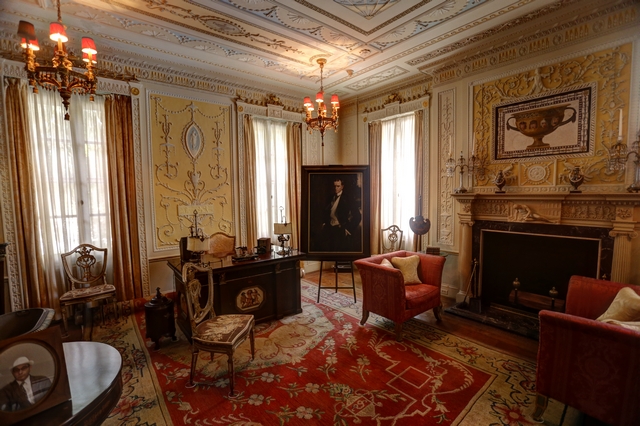
Every room has an unique style. This is the library. The portrait is of James Deering.

The music room.
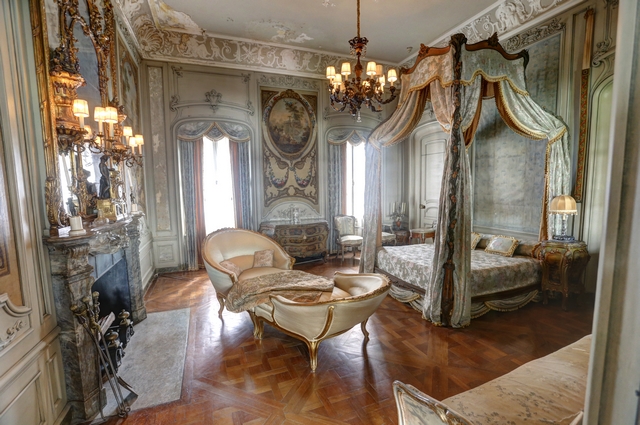
Each bedroom as given a name by Paul Chalfin the artistic director for the project.

The main dining room is on the first floor, a breakfast room is on the second floor and surprisingly the kitchen is on the second floor. Serving rooms are found outside both dining rooms. A dumb waiter is used to move the food between floors.
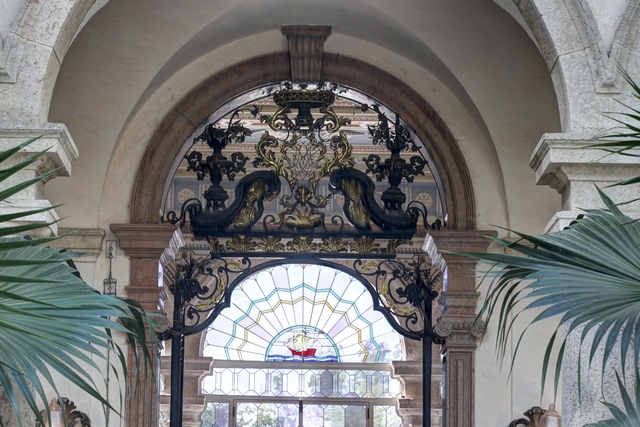
The transom in the door way between the courtyard and the enclosed loggia was intricate and lined up behind it is the stain glass window in the loggia looking out into the garden.
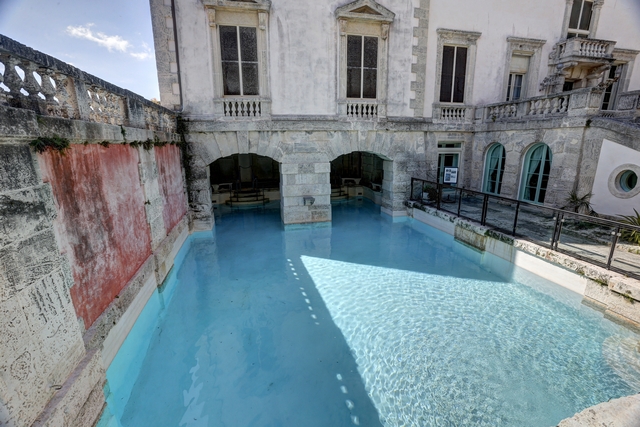
Part of the pool was under the living room.
Orchids and roses were James Deering's favourite flowers. Unfortunately, the area set aside for orchids was too sunny and too dry so alternative plants were used. Today, an area east of the house which is protected by trees has been made into an orchid garden.
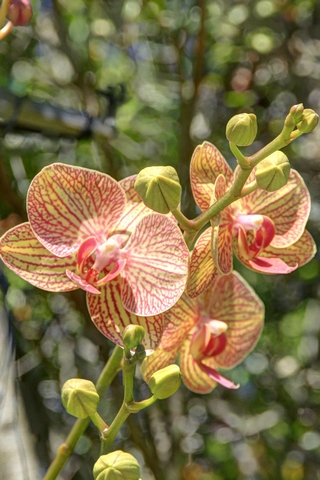
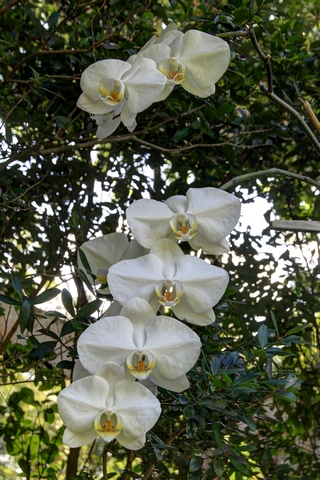
Pink orchids, orange orchids, red orchids, white orchids, etc. are in bloom.
There are several gardens, including a formal garden, a theater garden, maze garden and a fountain garden.
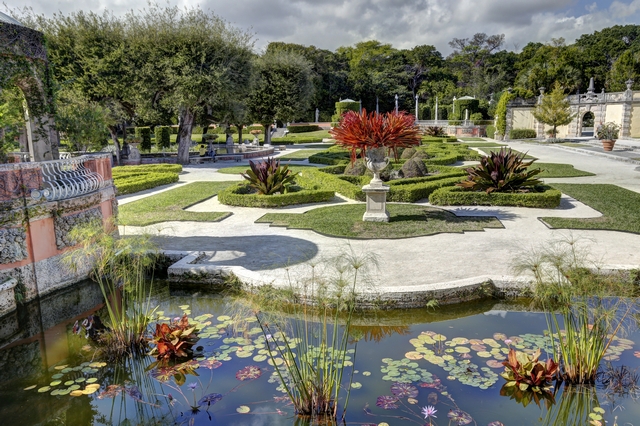
Looking across the front section of the formal garden.
The last section in the formal garden is a mound. At the back of the mound is a building whose actual purpose is unknown. When it was built it would have overlooked the "lagoon gardens", but the lagoon and it's gardens are long gone. The building, though, is beautiful.
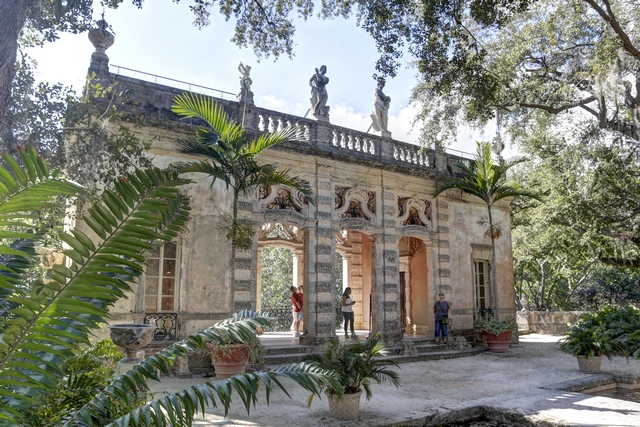
There is a enclosed room at each end of the building with open area between.

The house was designed with the front of the house facing Biscayne Bay as the early visitors to the house arrived by water.
The interior rooms are built around an open courtyard. In order to protect the interior of the house from the harsh Miami weather a glass roof was built over the courtyard and an air conditioning has been added.

Every room has an unique style. This is the library. The portrait is of James Deering.

The music room.

Each bedroom as given a name by Paul Chalfin the artistic director for the project.

The main dining room is on the first floor, a breakfast room is on the second floor and surprisingly the kitchen is on the second floor. Serving rooms are found outside both dining rooms. A dumb waiter is used to move the food between floors.

The transom in the door way between the courtyard and the enclosed loggia was intricate and lined up behind it is the stain glass window in the loggia looking out into the garden.

Part of the pool was under the living room.
Orchids and roses were James Deering's favourite flowers. Unfortunately, the area set aside for orchids was too sunny and too dry so alternative plants were used. Today, an area east of the house which is protected by trees has been made into an orchid garden.


Pink orchids, orange orchids, red orchids, white orchids, etc. are in bloom.
There are several gardens, including a formal garden, a theater garden, maze garden and a fountain garden.

Looking across the front section of the formal garden.
The last section in the formal garden is a mound. At the back of the mound is a building whose actual purpose is unknown. When it was built it would have overlooked the "lagoon gardens", but the lagoon and it's gardens are long gone. The building, though, is beautiful.

There is a enclosed room at each end of the building with open area between.
2017/02/02: Lighthouses and Art Deco
Category: General
Posted by: The Agnew Family
Bill Baggs Cape Florida State Park is a short drive from our house in
Little Havana. Driving along the Rickenbacker Causeway we see a lot of
beaches and even more parking lots. This area is probably packed on a
hot summer day.
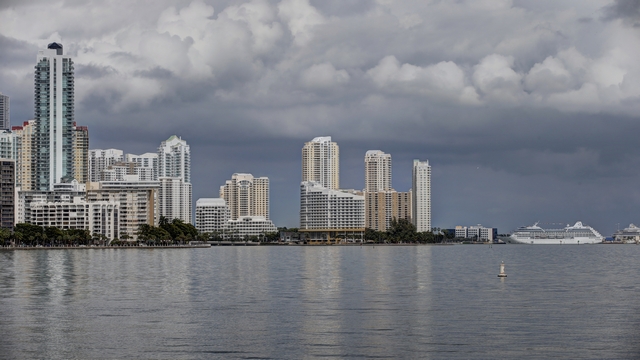
A view of Miami from the Rickenbacker Causeway.
At the southern most tip of Cape Florida is the 1845 brick Cape Florida Lighthouse.

The original lighthouse was damaged by a hurricane in 1835. In 1836, the lighthouse was attacked by Seminoles and burned. In 1846 a 2nd lighthouse was built. In 1855 the tower was raised to 95 feet to extend the reach of the light. The lighthouse was decommissioned in 1878 and remained inactive to 1893. The lighthouse became privately owned in 1893 switching hands several times before it was purchased by the state 1966 and restored. In 1992 the lighthouse survived Hurricane Andrew but the park suffered severe damages. In 1995/96 the lighthouse was restored back to the 1855 specifications.
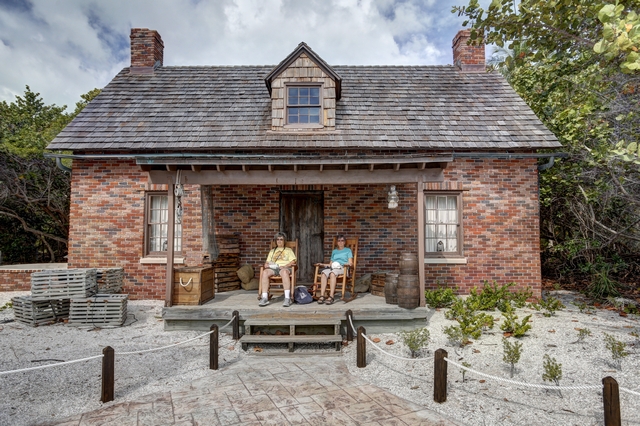
The original light keepers house has long ago fallen into the ocean (the ocean has been eroding the shoreline as it does everywhere). A replica of the original home was built in 1996 as part of the restoration.
We drove into South Beach to look at the art deco buildings. Miami Beach deco relies on 'stepped-back' facades that disrupt the harsh flat light. Cantilevered 'eyebrows' jut out above windows to protect interiors from the sun. I love architecture but don't know anything technical about it. I do know that I like the art deco style. It was hard to choose photos so there's quite a few here.
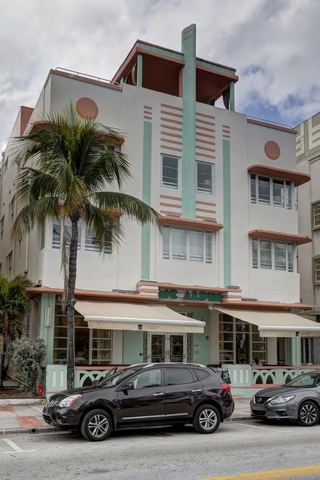
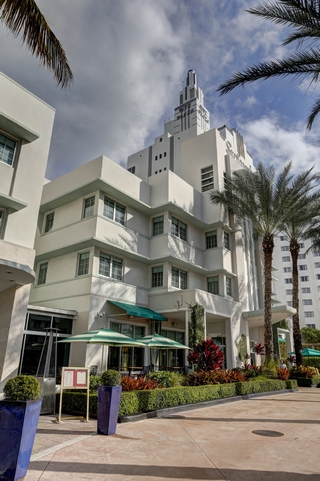
McAlpine Hotel was built in 1940 and designed by L. Murray Dixon. Not sure which building is in the right hand photo but I like the look.
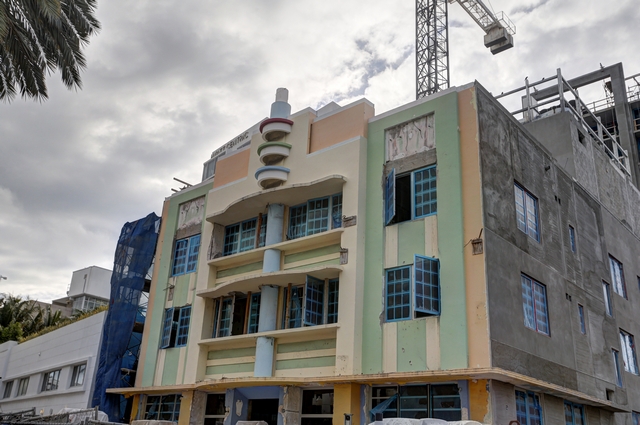
This art deco hotel is being gutted and a huge addition is being added to it. We saw a number of hotels where this had been done.
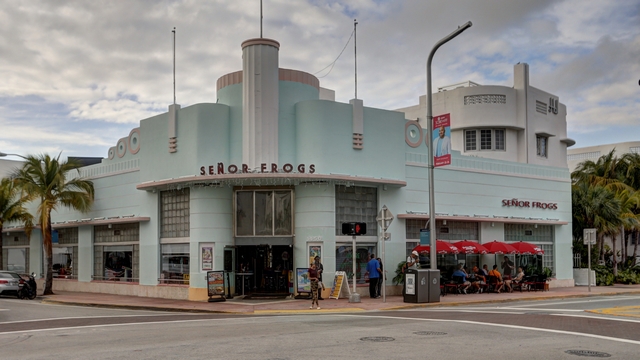
Hoffman's Cafeteria was built in 1938 and designed by \Henry Hohauser.

Old vehicles were parked in front of several of the hotels adding character. This is the Webster Hotel built in 1936 and designed by Henry Hohauser.
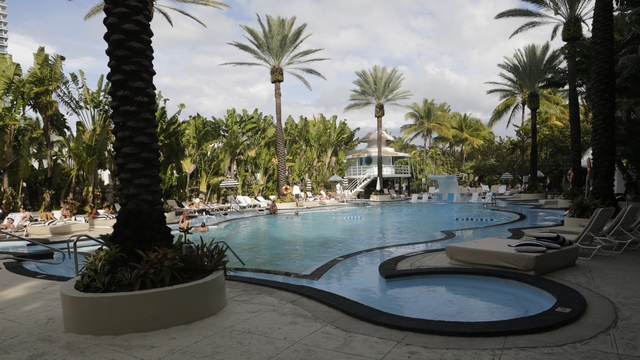
The art deco style continued inside several of the hotels and in this case the pool at the Raleigh Hotel (built in 1940 architect L. Murray Dixon).
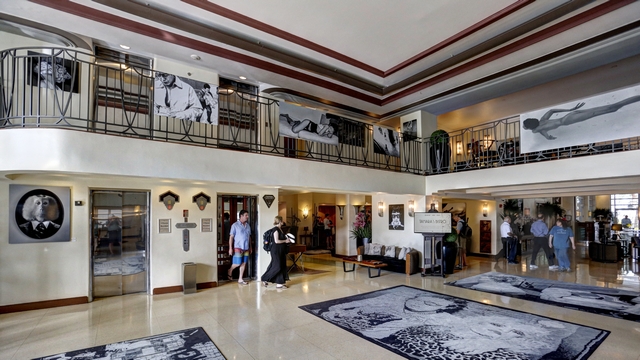
The lobby of the National Hotel (1940, designed by Robert Swartburg) continues the art deco look.

A beautiful fireplace was in the lobby of another hotel.

Art Deco is also found on the beach.
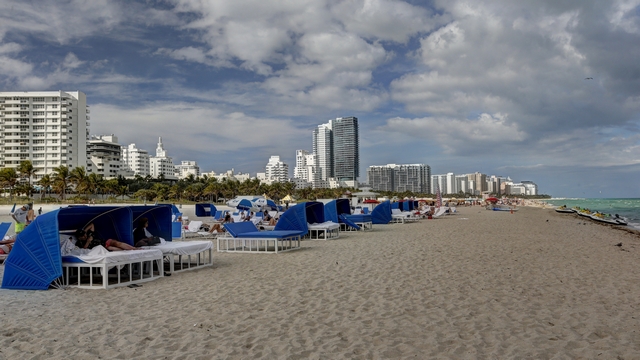
A shot down the beach. Lots of colourful umbrellas, chairs and huts dot the landscape of the beach.
We enjoyed dinner at one of the many restaurants on Ocean Drive while we waited for the sun to set. The hotels take on a new look with coloured lights.

Colony Hotel is the oldest deco hotel in Miami Beach.

Deco guru L. Murray Dixon designed the tower of this hotel to resemble a lighthouse.
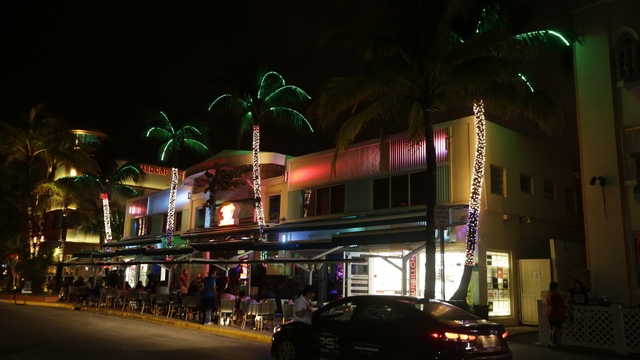
Decorated palm trees bring out the party atmosphere of South Beach.
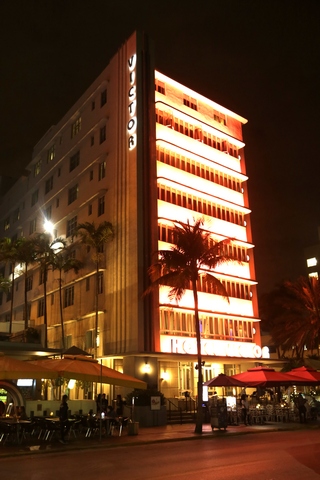
The Victor was built in 1937 and designed by L. Murray Dixon.

A view of Miami from the Rickenbacker Causeway.
At the southern most tip of Cape Florida is the 1845 brick Cape Florida Lighthouse.

The original lighthouse was damaged by a hurricane in 1835. In 1836, the lighthouse was attacked by Seminoles and burned. In 1846 a 2nd lighthouse was built. In 1855 the tower was raised to 95 feet to extend the reach of the light. The lighthouse was decommissioned in 1878 and remained inactive to 1893. The lighthouse became privately owned in 1893 switching hands several times before it was purchased by the state 1966 and restored. In 1992 the lighthouse survived Hurricane Andrew but the park suffered severe damages. In 1995/96 the lighthouse was restored back to the 1855 specifications.

The original light keepers house has long ago fallen into the ocean (the ocean has been eroding the shoreline as it does everywhere). A replica of the original home was built in 1996 as part of the restoration.
We drove into South Beach to look at the art deco buildings. Miami Beach deco relies on 'stepped-back' facades that disrupt the harsh flat light. Cantilevered 'eyebrows' jut out above windows to protect interiors from the sun. I love architecture but don't know anything technical about it. I do know that I like the art deco style. It was hard to choose photos so there's quite a few here.


McAlpine Hotel was built in 1940 and designed by L. Murray Dixon. Not sure which building is in the right hand photo but I like the look.

This art deco hotel is being gutted and a huge addition is being added to it. We saw a number of hotels where this had been done.

Hoffman's Cafeteria was built in 1938 and designed by \Henry Hohauser.

Old vehicles were parked in front of several of the hotels adding character. This is the Webster Hotel built in 1936 and designed by Henry Hohauser.
The art deco style continued inside several of the hotels and in this case the pool at the Raleigh Hotel (built in 1940 architect L. Murray Dixon).

The lobby of the National Hotel (1940, designed by Robert Swartburg) continues the art deco look.
A beautiful fireplace was in the lobby of another hotel.

Art Deco is also found on the beach.

A shot down the beach. Lots of colourful umbrellas, chairs and huts dot the landscape of the beach.
We enjoyed dinner at one of the many restaurants on Ocean Drive while we waited for the sun to set. The hotels take on a new look with coloured lights.
Colony Hotel is the oldest deco hotel in Miami Beach.
Deco guru L. Murray Dixon designed the tower of this hotel to resemble a lighthouse.
Decorated palm trees bring out the party atmosphere of South Beach.
The Victor was built in 1937 and designed by L. Murray Dixon.
2017/02/01: Birds and Gators
Category: General
Posted by: The Agnew Family
Shark Valley is not a valley with Sharks but rather an area in the
Everglades National Park. Shark Valley lies in the heart of the "True
Everglades," or river of grass, that stretches 100 miles from Lake
Okeechobee to the Gulf of Mexico. An observation tower is at the mid
point of a 15 mile (round trip) road that goes into the everglades. You
can hike, bike or take a tram. We opted for the tram ride and then we
did the couple of short hikes. The road to the tower was built by an oil
company when they were looking for oil. Luckily no oil was found and
the land was donated to the federal government for a park. The road from
the tower back to the visitor center, completing the loop, was built by
park services.

Looking out over the sawgrass at the trees in the distance.
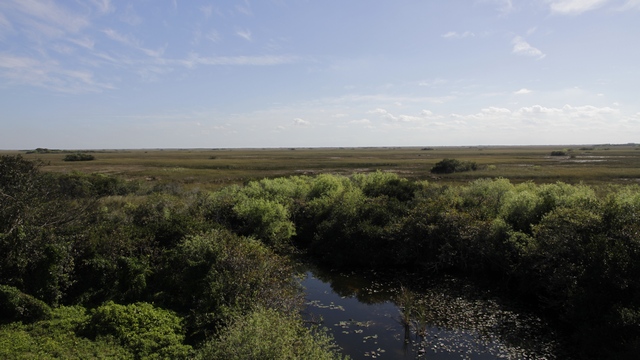
A view from the observation tower. The tower began life as a fire tower. Today instead of putting out fires the park rangers do controlled burns.
We saw lots and lots and lots of birds and alligators, so Ed shot a humongous number of photos and some of them were even good (actually a lot of them were good). This means I'm posting more than the normal number of photos.
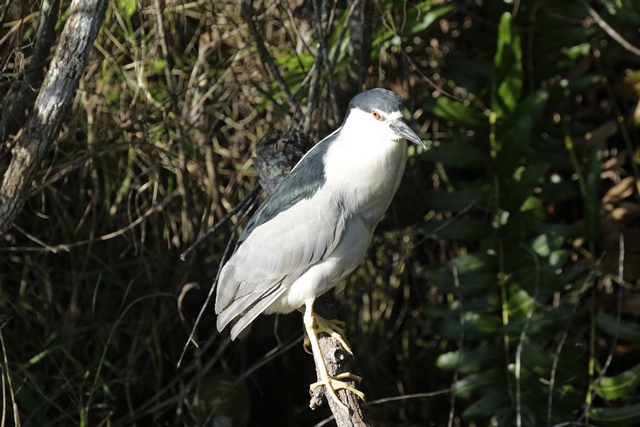
Night Heron.
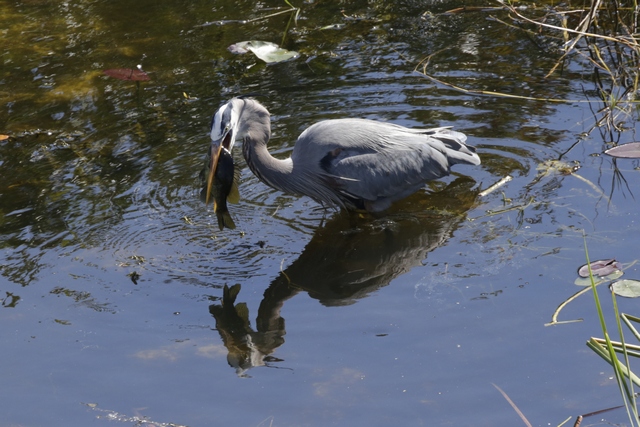
Yum! Lunch is served. Great Blue Heron.
We saw a lot of alligators today, some swimming, some sleeping, some big, some small and some downright tiny. Yup, we got to see baby alligators. Alligator babies may stay in "the pod" with their mother for up to three years.
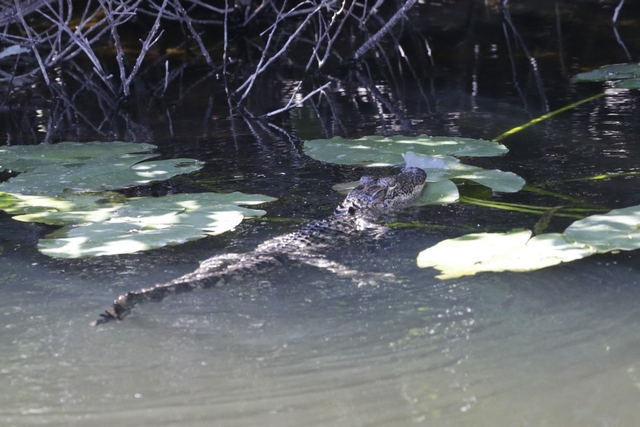
Baby Alligator tromping through the lily pads.
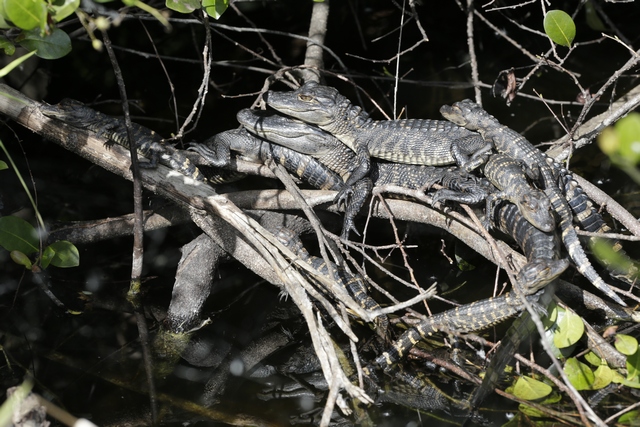
Seven Alligator pileup. Mom was just across the road ---- watching. Can you find all seven?
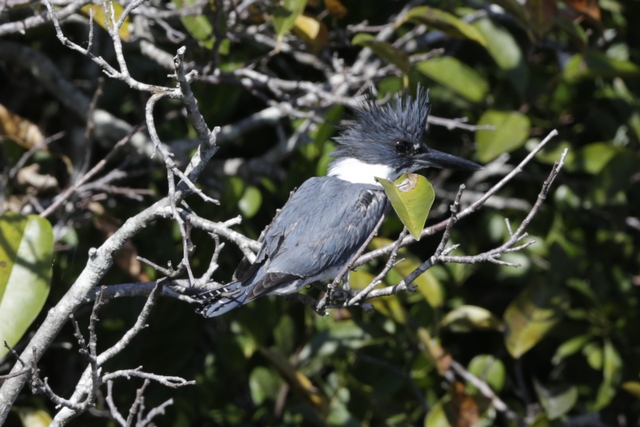
Belted Kingfisher having a bad hair day.

Glossy Ibis --- first we've seen on this trip. The Ibis has a chestnut brown head and neck and iridescent green and blue wings and tail.
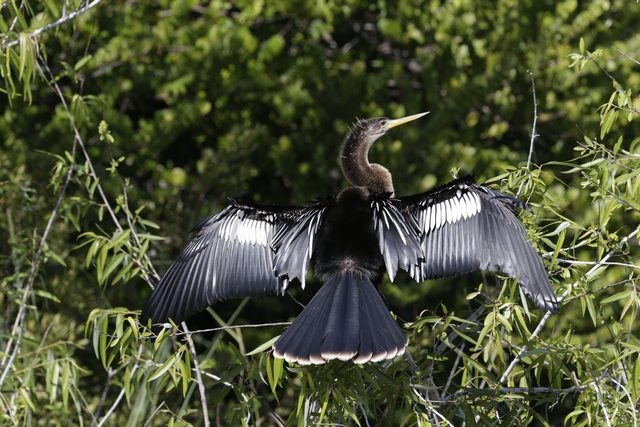
A female Anhinga drying her wings.
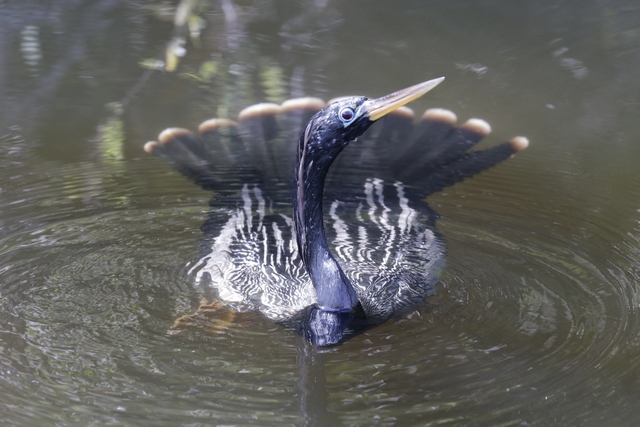
A male Anhinga surfacing after a dive. The body and tail are still under water.

A Green Heron in normal respose
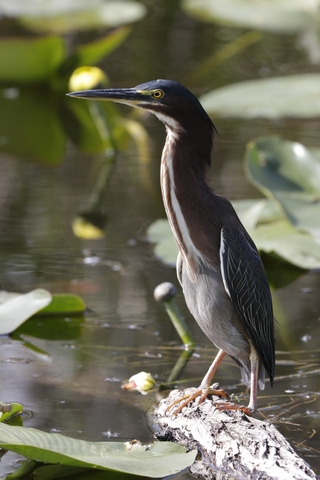
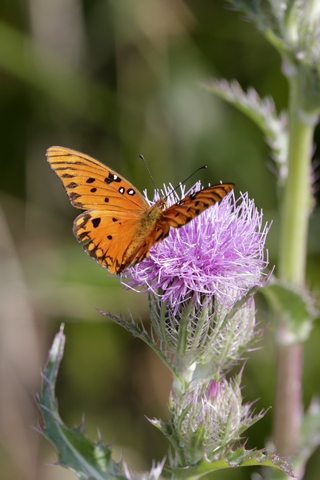
A Green Heron with his neck extended --- probably looking for a fish. We also saw a number of different butterflies. They seemed to like the thistles.

Turtle but don't have a clue of the type,
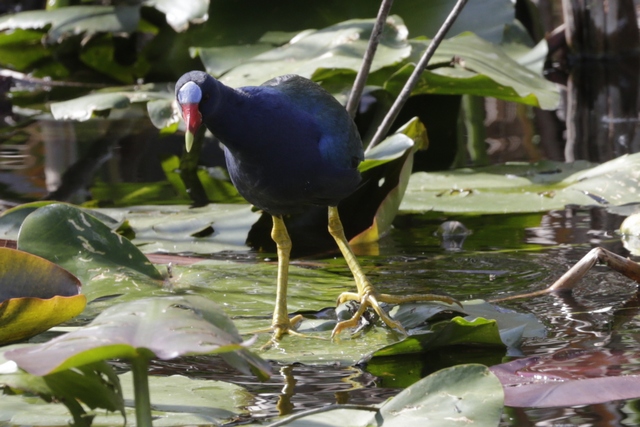
Ed's been looking for this bird since we arrived in Florida. It is the Purple Gallinule.
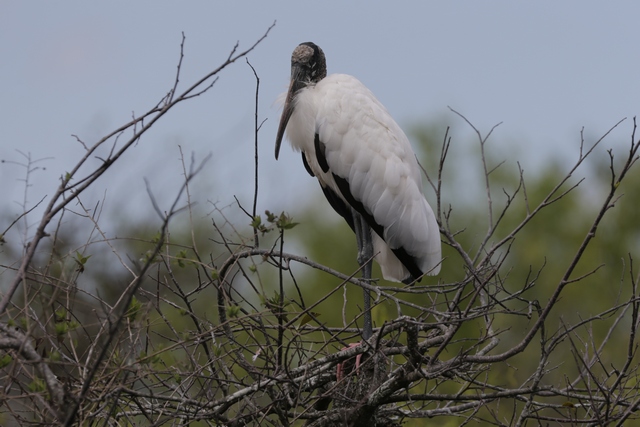
The Wood stork is a large American wading bird. It is classified as a threatened species by the US Fish & Wildlife Services.
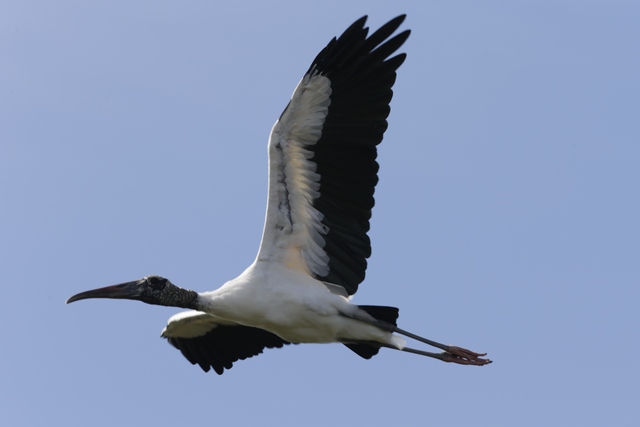
Wood stork flying about.
Looking out over the sawgrass at the trees in the distance.
A view from the observation tower. The tower began life as a fire tower. Today instead of putting out fires the park rangers do controlled burns.
We saw lots and lots and lots of birds and alligators, so Ed shot a humongous number of photos and some of them were even good (actually a lot of them were good). This means I'm posting more than the normal number of photos.
Night Heron.
Yum! Lunch is served. Great Blue Heron.
We saw a lot of alligators today, some swimming, some sleeping, some big, some small and some downright tiny. Yup, we got to see baby alligators. Alligator babies may stay in "the pod" with their mother for up to three years.
Baby Alligator tromping through the lily pads.
Seven Alligator pileup. Mom was just across the road ---- watching. Can you find all seven?
Belted Kingfisher having a bad hair day.
Glossy Ibis --- first we've seen on this trip. The Ibis has a chestnut brown head and neck and iridescent green and blue wings and tail.
A female Anhinga drying her wings.
A male Anhinga surfacing after a dive. The body and tail are still under water.
A Green Heron in normal respose
A Green Heron with his neck extended --- probably looking for a fish. We also saw a number of different butterflies. They seemed to like the thistles.
Turtle but don't have a clue of the type,
Ed's been looking for this bird since we arrived in Florida. It is the Purple Gallinule.
The Wood stork is a large American wading bird. It is classified as a threatened species by the US Fish & Wildlife Services.
Wood stork flying about.